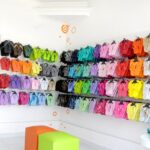Find out in (8) steps how to set up a slipper factory
Find out in (8) steps how to set up a flip-flop factory
Flip-flops are part of Brazilian culture and are used by millions of people every day. In addition, factors such as the demand for custom sandals have led many individuals to want to undertake this market.Despite this desire, the vast majority of people just don’t know where to start and don’t have the slightest idea how to set up a slipper factory. In fact, most entrepreneurs are not even sure if this is really the best way to enter this market.
Given this reality, we decided to prepare this article to introduce you to the step-by-step guide to setting up a flip-flop factory.
Read our content and find out if this is indeed the best venture for you!understand the marketWhen we think about successful businesses, and the growth of large companies, it is easy to come to the conclusion that factors such as motivation are of great importance. After all, without committed leadership, abusiness has no way out.The big question is that, as much as the will to win and motivation are really important, an entrepreneur cannot focus only on them and leave aside the knowledge necessary to open his company.
For this reason, before setting up a flip-flop factory, it is up to the entrepreneur to check if there are already such businesses operating in their region. If the answer is yes, this does not necessarily mean that opening the factory is unfeasible, but it will need to have an even clearer differential, to stand out from its competitors.In addition, opening a factory is not always the best option.
Buying flip flops wholesale or implementing private label can be more affordable and efficient solutions.In any case, at this first moment, it is up to the entrepreneur to develop a well-structured business plan that considers all these factors.
2. Take care of bureaucratic issuesAll companies operatingin national territory have to deal with charges and taxes.
For this reason, one of the most relevant points, when we think about how to set up a flip-flop factory, are the bureaucratic issues.Firstly, the entrepreneur needs to do a survey at the city hall of the city where he wants to open the factory, to verify the areas in which this type of business can be installed. After this process is closed, he needs to ask for a series of authorizations from agencies such as the city hall and the Fire Department.
The entrepreneur still needs to register the company with a commercial board and decide what its legal status will be. Taking into account factors such as the incidence of taxes, and even the ease of paying them, Simples Nacional is usually the best option for businesses that are starting.It is worth mentioning that, for the company to avoid problems with institutions such as the Federal Revenue, its management of taxes and labor charges must be done in aefficient. Which requires the services of a team of specialized accountants.
3. Invest in the acquisition of machinesIn addition to the expenses related to complying with bureaucracy and the costs of renting — or purchasing — a commercial point to set up the flip-flops factory, the entrepreneur also needs to invest in the purchase of the machines and equipment necessary for the production of sandals and slippers.At this point, it is up to the entrepreneur to choose between acquiring second-hand machines – which are usually cheaper and a little less reliable – or new machines, which are more reliable and have a guarantee, but have a higher value.
The entrepreneur — who wants to build a successful business — also needs to consider that even a new machine requires maintenance care. Which means that he will have to choose between hiring employees to perform this task or outsourcing the service to a specialized company.Furthermore, to guarantee the capital of thebusiness, the entrepreneur must consider the costs with the energy necessary for the operation of the machinery, with its spare parts and even with the oils and lubricants necessary for its maintenance routines.
Considering these costs, the purchase of flip flops wholesale and the outsourcing of their production, through the private label, can stand out as the most interesting options for the entrepreneur.4. Look for reliable suppliersNo matter how advanced and efficient the machines are, they will not be able to operate without raw materials.
That’s why one of the most important steps to set up a flip-flop factory is the search for a good supplier.
Obviously, the entrepreneur needs to look for prices that allow him to make the slippers available, manufactured by him, at a cost that fits his consumers’ pockets. The point is that a lower price should not be determined at the expense of quality.
If the rubber — used in the production of flip-flops — is bad, theflip-flops made using it tend to sink quickly and have little durability. These characteristics would leave any customer dissatisfied, and that would negatively affect the image of the business.To avoid this problem, the entrepreneur must choose to buy good quality raw materials, which may have a higher price. A solution to this problem is the acquisition of a larger amount of inputs.
By making a larger purchase, the factory can get a discount and spread some of its costs. Before making this decision, however, business managers need to verify that a large purchase actually fits within their budget.
5. Hire professionalsWhile quality machinery and raw materials are indispensable, the workforce of employees is no less important. After all, they are largely responsible for operating the equipment and thus transforming raw materials — such as rubber — into flip-flops and sandals.Given this reality, it is no mistakeconsider employees as company assets. The leader needs to keep in mind that the company’s productivity is directly linked to employee engagement.
Therefore, he needs to provide a suitable working environment for them.In addition, since professionals will need to deal with machines, it is necessary that they receive the proper training. This attitude is essential both for accidents to be avoided and for the employee to fully use the machine, without the risk of damaging it.It is worth noting, however, that to set up a slipper factory, the entrepreneur will not only need professionals to work on the factory floor.
The company will also need staff to handle more administrative functions, such as a secretary and salespeople.Not to mention a team of designers, essential for the flip-flops, produced by the factory, to be in line with market trends.
6. Invest in security measuresOneperson who wants to know how to set up a slipper factory needs to keep in mind that any accident that occurs on the factory premises will be under his/her responsibility.
So the company can answer for them.To avoid this type of problem, the entrepreneur needs to invest both in safety devices and in training and accident prevention measures. It is of paramount importance that employees understand the risks to which they are subject, and that they know what precautions to take to ensure their physical integrity and that of their colleagues.Entrepreneurs who work with the private label, and those who buy flip flops wholesale, in turn, do not need to deal with these factors. Which ends up reducing the risks of their operation, so they can focus on selling without worries.
7. Create promotion and sales strategiesThe entrepreneur—who wants to set up a slipper factory—needs to keep in mind that, in the beginning, practically no one willknow your company.
So he needs to develop dissemination and marketing strategies.Fortunately, tools like Facebook ADS and Google ADS, capable of driving ads, have the potential to make the factory reach a large number of people. In addition, well-structured SEO strategies and smart use of social media are also capable of widely publicizing the new flip-flop factory and its products.Leaders need to keep in mind, however, that there is no such thing as magic.
And that your competitors also make use of such tools. For this reason, the company needs to develop effective marketing strategies to promote its brand.To ensure the effectiveness of this process, it is ideal that the factory leaders have the support of specialized professionals.
8. Take care of shipping the productsIt is important for the entrepreneur to keep in mind that, after the sale is closed, he needs to make sure that the sold slippers reach thebuyer. Which can be done by means of own vehicles and specialized carriers.
Regardless of the shipping model, the entrepreneur needs to consider shipping costs, if they are too high, the customer may simply give up on making the purchase. It is clear that the owner of the new slipper factory may choose to bear these costs, but this attitude can reduce their margins, making the operation unfeasible.As a solution, the entrepreneur can focus on closer areas, where shipping products is cheaper. Since shipping delays can affect the image of the factory — even if they are caused by carrier problems — the entrepreneur needs to dedicate time to finding a reliable partner.After all, as with the suppliers of raw materials, those responsible for transport also directly impact the operation of the factory.Analyzing the points that were presented, we can see that setting up a slipper factory isviable, but that this process is linked to a series of costs and responsibilities that make it quite complex.In this context, companies that buy flip flops wholesale, or that operate in the private label model, end up having an advantage.
This is because, in this type of operation, the entrepreneur can focus only on sales and shipping strategies, and does not have to worry about the production steps.How about having access to support from a reliable flip-flops and sandals supplier with years of experience in the market?
Our Site Arte Chinelos!









